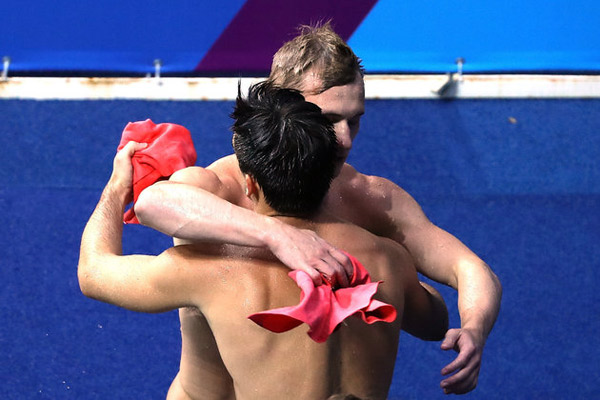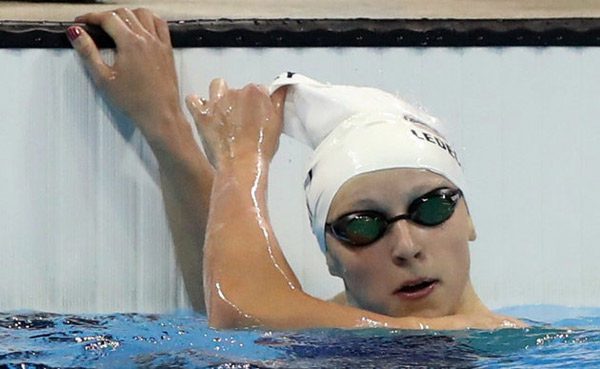當(dāng)前位置: Language Tips> 雙語新聞
All the answers to the swimming questions you're too afraid to ask
分享到
If you’ve been watching the Rio Olympic swimming events, chances are you have some questions that you may be too afraid to ask. That’s why we’ve dug up the answers to some of your top swimming questions:
如果你一直在關(guān)注里約奧運會的游泳賽事,你可能會產(chǎn)生些好奇又不好意思問的問題。為此,我們會為大家在下文專門解答最引人不解的游泳問題。
1. Why do Olympic divers use small towels?
為什么奧運會跳水運動員用小浴巾?

Why do divers at #Olympics use really small towels that I’d really call face cloths?
— Laura Meakin (@la_steel64) August 10, 2016
為什么參加奧運會的跳水運動員用這么小的浴巾?稱之為擦臉毛巾都不為過!
——勞拉·米金 賬號@la_steel64 2016年8月10日
Olympic gold medalist Laura Wilkinson explains that the name of these little towels are called shammys. The shammy, made out of rayon or poly-vinyl, can hold a lot of water and dry quickly, the former US diver reveals.
前美國跳水運動員、奧運金牌得主勞拉·威爾金森表示,這些“小方巾”名為麂皮革。這種由人造纖維絲或聚乙烯醇樹脂制成的麂皮革可以快速吸干運動員身上的大量水分。
Divers use shammys in between dives to dry off. Shammys come in handy in between dives because it helps keep your hands and legs dry, and prevents the diver from losing grip when competing.
運動員在每次跳水間隔都會用麂皮革吸干身上的水分。這種用于休息間隔的麂皮革可以確保運動員手腳干燥,還能避免他們在比賽時失去控制。
“It becomes a habit that you do before every dive. It’s kind of like our safety blanket,” Wilkinson says.
“我們習(xí)慣于在每次跳水前都擦干手腳。麂皮革有點像跳水運動員的安全毯。”威爾金森表示。
2. Why do Olympic divers get into the hot tub after competing?
為什么奧運跳水選手在比賽后都要用熱水淋浴?
Why do the divers go into the hot tub after there dive? #Rio2016 #Olympics
— Chloe (@chloedenvir) August 10, 2016
為什么運動員在跳水完緊接著就去熱水浴池呢?#里約2016#奧運會
——克洛伊 賬號@choledenvir 2016年8月10日
During the summer 2012 Olympics, The Washington Post’s Jennifer LaRue Huget asked former diver and sports psychology professor David Feigley why some Olympic divers dip in the hot tub after diving. It’s simply because the water in the diving pool is chilly (which divers don’t like) and the hot tub allows them to warm up, relax and focus, he explains.
2012年夏季奧運會期間,《華盛頓郵報》的記者詹妮弗·拉呂·休格特曾就這個問題采訪運動心理學(xué)教授、前跳水運動員大衛(wèi)·費格利, 他表示運動員在跳水后進行熱水淋浴僅僅是因為跳水池里的水很冷(這讓他們感到不適),而熱水澡既能讓他們暖和,又能讓他們放松,將注意力集中到下場比賽。
3. Why are there lifeguards at Olympic pools?
為什么奧運會泳池旁會有救生員?
If you ever feel like you’re wasting your life in a pointless job, remember those who are lifeguards at the Olympics
— Meanwhile In Scotia (@MeanwhileScotia) August 8, 2016
要是你曾覺得自己在毫無意義的工作上浪費生命,不妨想想那些奧運會場救生員。
——Meanwhile in Scotia 賬號@MeanwhileScotia 2016年8月8日
You may think there is zero chance of Olympic swimmers needing lifeguards. But it’s necessary, according to a New York Times interview with Danielle Martelote, the lifeguard supervisor at the Olympic Aquatics Stadium. She mentions potential situations they would be needed in, such as if swimmers have debilitating cramps, heart attacks and head-crunching collisions into the wall.
你或許會認為奧運水上運動員需要救生員的幾率為零。但救生員在賽場上仍必不可少,《紐約時報》曾就此對話奧林匹克游泳館救生員主管丹妮爾·馬特洛特。她解釋道,即便是專業(yè)的運動員也會有嚴(yán)重抽筋、心臟病突發(fā)、以及頭部撞墻的危險。
Additionally, a Brazilian law requires lifeguards to be on-site at any swimming pool larger than 20 feet by 20 feet.
此外,巴西有專門的立法規(guī)定,尺寸大于20英尺乘20英尺的游泳池都必須配備救生員。
“It’s a one-in-a-million type of event, but we’re prepared,” Anderson Fertes, one of the lifeguards, told The New York Times.
“雖然這種事發(fā)生的概率極小,我們還是為此做好了充分的準(zhǔn)備。”救生員安德森·費爾特斯告訴《紐約時報》的記者。
4. What are the red circles on swimmers’ bodies?
游泳運動員身體上的深紅圓形印記是什么?
FUN FACT: Those circles are the end product of an ancient healing technique called cupping. #Rio2016
— NBC Olympics (@NBCOlympics) August 8, 2016
謎底揭開:這些暗紅圓點是一種名為“拔火罐”的古老醫(yī)術(shù)帶來的印記。#里約
——NBC奧運官媒 賬號@NBCOlympics 2016年8月8日
According to USA Today, the suction of the cups, sometimes heated, is said to enhance blood flow. Whatever the effect, it seemed to work for the heavily decorated swimming god.
《今日美國》報道,拔火罐可借助熱力加速人體血液循環(huán)。不管它的效果如何,身帶這種“紋身”似乎能得到游泳之神的庇護。
5. Why do Olympic swimmers splash water on themselves before they swim?
為什么奧運選手在游泳前要在自己身上撲水花?
Can someone please tell me why swimmers splash all of that water in their face before they swim? #idontgetit #asktwitter
— Heather Hannon ? (@heathhhan) August 3, 2012
有沒人告訴我為啥運動員在游泳前要把水撲到自己臉上啊?#我不明白#求助推特
——希瑟·漢農(nóng)? 賬號@heathhhan 2012年8月3日
You may have noticed that some Olympic divers splash water onto themselves before competing. American swimmer Breeja Larson tweeted “Your mouth feels parched before races a lot of the time. That’s why we splash,” according a New York Times article published during the London 2012 Olympics. Splashing water can also help swimmers acclimatize to the cold water.
你可能也注意到了有些跳水運動員會在比賽前往自己臉上灑水。《紐約時報》在2012年倫敦奧運會期間報道過,美國游泳運動員布里亞·拉爾森曾發(fā)推文解釋稱“大多數(shù)比賽前我們都會覺得很干,這就是為什么我們會往身上灑水,”往身上灑水還能夠讓運動員提前適應(yīng)賽場的寒冷水溫。
6. Why do swimmers wear two caps?
為什么游泳運動員要戴兩層泳帽?

The first reason is that the two caps ensure your goggles will stay secure. The second reason isn’t as obvious. According to Salo, “the outer silicone cap better maintains the shape and does not wrinkle as much, thereby causing less drag.” The inner cap is generally latex.
第一層原因是兩層泳帽能夠幫助運動員固定泳鏡。第二層原因就不是那么明顯了,薩洛表示,“外層的硅膠泳帽一般不會起皺,能夠更好地保持表面平滑度,減少在水中的阻力。”內(nèi)層的泳帽一般都是乳膠材質(zhì)。
Vocabulary
shammy: 麂皮革
latex: 乳膠
英文來源:赫芬頓郵報
翻譯:陳蕾羽(中國日報網(wǎng)愛新聞iNews譯者)
審校&編輯:丹妮
上一篇 : 里約奧運村發(fā)套套的小哥火了
下一篇 : 拼搏在奧運賽場的老將們
分享到
關(guān)注和訂閱


翻譯
關(guān)于我們 | 聯(lián)系方式 | 招聘信息
電話:8610-84883645
傳真:8610-84883500
Email: languagetips@chinadaily.com.cn